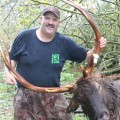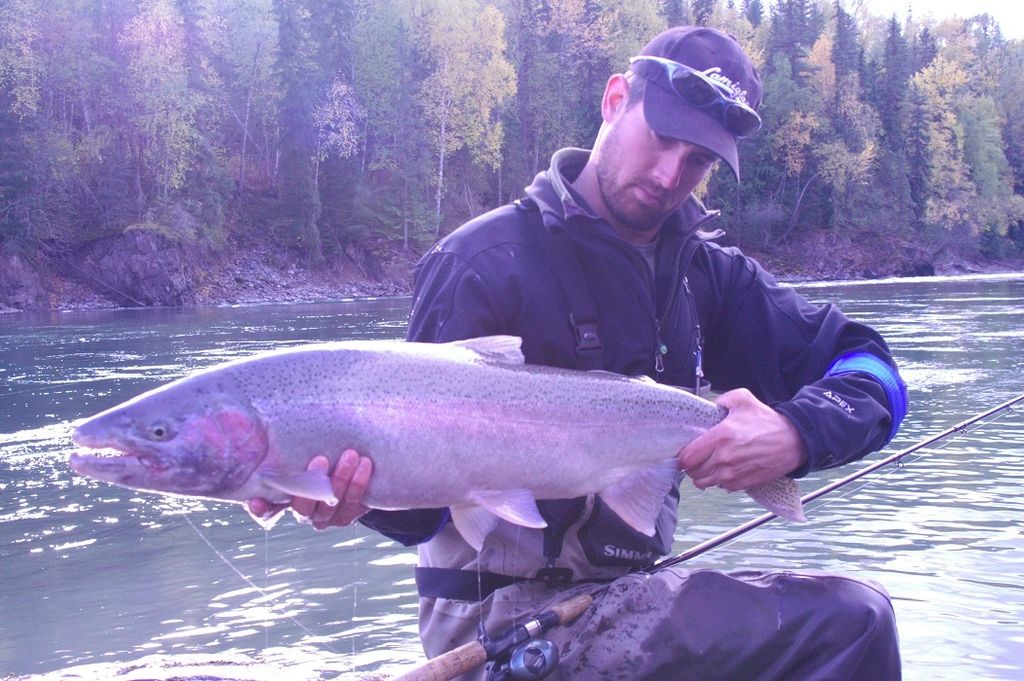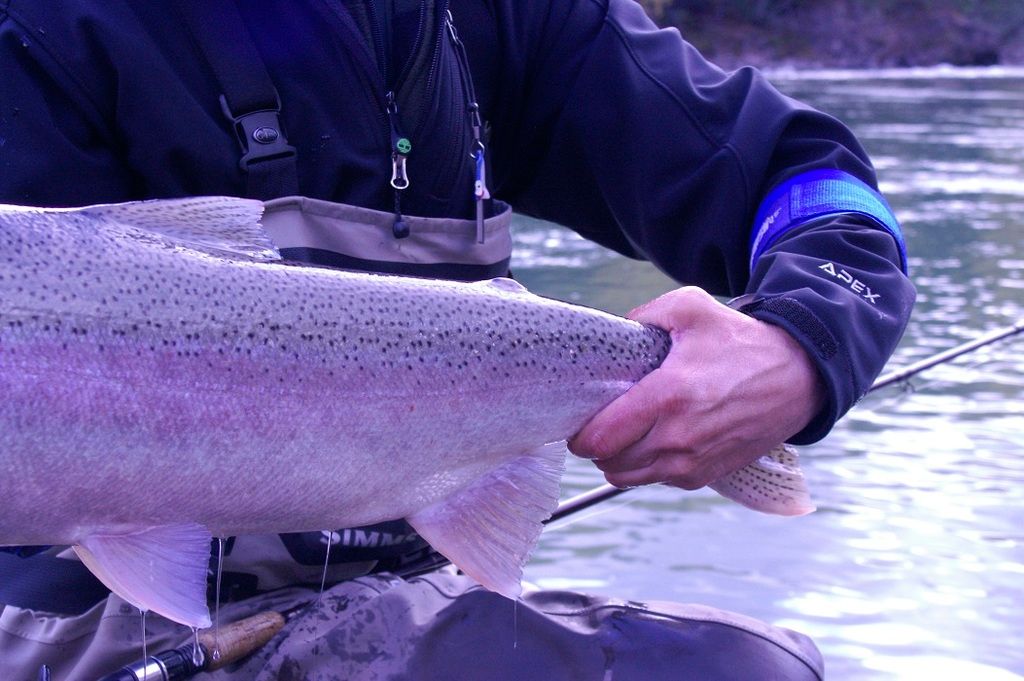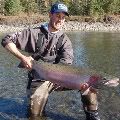I found this article, I'm not a biologist but I know there is someone on this forum is ... I have surface knowledge about this subject. I would love to get Tom's Opinion on this article..
http://westseattleblog.com/2014/12/when ... r-anglers/
The Outdoor Line
EXPERT DRIVEN Hunting & Fishing Talk Radio - 710 AM
Hatcheries/ no hatcheries (Tom's Take)
8 posts
• Page 1 of 1
-

LisaMarie - Pecker Trout
- Posts: 100
- Joined: Sat Jan 15, 2011 8:33 am
Re: Hatcheries/ no hatcheries (Tom's Take)
Hey LM,
Thanks for sparking a discussion on this issue
Ahh, the West Seattle Blog... That stalwart bastion of factual, balanced "journalism"
In reading that article, and in essence being forced to accept at face value the conclusions arrived without benefit of a shred of scientific proof... Well, let's just say I was fairly disgusted at the depth to which the writer and the subject had swallowed the anti-hatchery "bait".
Here's the deal: To have robust fish runs that support fisheries you need HABITAT!
If you've logged & developed, drained & diked, dumped and dammed (no debate there...we have) then your habitat is compromised and you need HATCHERIES!
Closing hatcheries is a cop-out. Is the State or Feds going to place the money intended for hatchery operation -the majority of which comes from license fees and taxes SPORTSMAN'S DOLLARS- on fisheries enhancements and habitat improvements? Think so? Me neither!
Me neither!
Unless or until we rehabilitate our habitat, we are absolutely dependent upon our hatcheries. Make no mistake, I wish we did not need hatcheries... But, we do.
Hatcheries are a tool in the overall process of recovering our salmonid resources.
If a tool is not doing the job you desire it to do...you DON'T BLAME THE TOOL!
Thanks for sparking a discussion on this issue

Ahh, the West Seattle Blog... That stalwart bastion of factual, balanced "journalism"
In reading that article, and in essence being forced to accept at face value the conclusions arrived without benefit of a shred of scientific proof... Well, let's just say I was fairly disgusted at the depth to which the writer and the subject had swallowed the anti-hatchery "bait".
Here's the deal: To have robust fish runs that support fisheries you need HABITAT!
If you've logged & developed, drained & diked, dumped and dammed (no debate there...we have) then your habitat is compromised and you need HATCHERIES!
Closing hatcheries is a cop-out. Is the State or Feds going to place the money intended for hatchery operation -the majority of which comes from license fees and taxes SPORTSMAN'S DOLLARS- on fisheries enhancements and habitat improvements? Think so?
Unless or until we rehabilitate our habitat, we are absolutely dependent upon our hatcheries. Make no mistake, I wish we did not need hatcheries... But, we do.
Hatcheries are a tool in the overall process of recovering our salmonid resources.
If a tool is not doing the job you desire it to do...you DON'T BLAME THE TOOL!

The Outdoor Line on 710 ESPN Seattle 6-9am Every Saturday!
-

Nelly - Spawned Out Boot
- Posts: 2261
- Joined: Tue Dec 28, 2010 9:04 am
Re: Hatcheries/ no hatcheries (Tom's Take)
Which brings the question how can we have large returns of pinks in the snohomish / Skykomish yet the Chinook seem to suffer dwindling numbers? Again I'm not expert on the subject and Tom I know you are... Not trying to call anyone out, just trying to get educated
-

LisaMarie - Pecker Trout
- Posts: 100
- Joined: Sat Jan 15, 2011 8:33 am
Re: Hatcheries/ no hatcheries (Tom's Take)
The following (below) was a summary derived from the Hatchery Scientific Review Group (HSRG) - which was composed of a large number of highly knowledgeable people -
(see: http://hatcheryreform.us/hrp/about/memb ... how.action).
In this, please note that there were concerns about hatcheries, but the HSRG did not indicate the need to eliminate them, as some have indicated.
The Hatchery Scientific Review Group (HSRG) conducted a comprehensive review of 178 hatchery programs and 351 salmon and steelhead populations in Puget Sound/Coastal Washington and the Columbia River Basin. The resulting population-specific recommendations are intended to provide scientific guidance for managing each hatchery more effectively in the future.
The HSRG concluded that hatcheries play an important role in the management of salmon and steelhead populations in the Pacific Northwest. Nevertheless, the traditional practice of replacing natural populations with hatchery fish to mitigate for habitat loss and mortality due to hydroelectric dams is not consistent with today's conservation principles and scientific knowledge. Hatchery fish cannot replace lost habitat or the natural populations that rely on that habitat.
Therefore, hatchery programs must be viewed not as surrogates or replacements for lost habitat, but as tools that can be managed as part of a coordinated strategy to meet watershed or regional resource goals, in concert with actions affecting habitat, harvest rates, water allocation and other important components of the human environment. Hatchery programs should be used only to the extent that they provide a better option—from the benefit-risk standpoint—than available alternative methods to meet the same or similar goals.
The HSRG has reached several critical, summary conclusions regarding areas where current hatchery and harvest practices need to be reformed. Each of these conclusions (listed below and described in detail in the System-Wide Report on Columbia River Basin Hatchery Reform) must be addressed through policy, management, research and monitoring:
[list=]
Promote local adaptation of natural and hatchery populations;
Minimize adverse ecological interactions between hatchery- and natural-origin fish;
Minimize effects of hatchery facilities on the ecosystem; and
Maximize survival of hatchery fish.[list=][i]
(see: http://hatcheryreform.us/hrp/about/memb ... how.action).
In this, please note that there were concerns about hatcheries, but the HSRG did not indicate the need to eliminate them, as some have indicated.
The Hatchery Scientific Review Group (HSRG) conducted a comprehensive review of 178 hatchery programs and 351 salmon and steelhead populations in Puget Sound/Coastal Washington and the Columbia River Basin. The resulting population-specific recommendations are intended to provide scientific guidance for managing each hatchery more effectively in the future.
The HSRG concluded that hatcheries play an important role in the management of salmon and steelhead populations in the Pacific Northwest. Nevertheless, the traditional practice of replacing natural populations with hatchery fish to mitigate for habitat loss and mortality due to hydroelectric dams is not consistent with today's conservation principles and scientific knowledge. Hatchery fish cannot replace lost habitat or the natural populations that rely on that habitat.
Therefore, hatchery programs must be viewed not as surrogates or replacements for lost habitat, but as tools that can be managed as part of a coordinated strategy to meet watershed or regional resource goals, in concert with actions affecting habitat, harvest rates, water allocation and other important components of the human environment. Hatchery programs should be used only to the extent that they provide a better option—from the benefit-risk standpoint—than available alternative methods to meet the same or similar goals.
The HSRG has reached several critical, summary conclusions regarding areas where current hatchery and harvest practices need to be reformed. Each of these conclusions (listed below and described in detail in the System-Wide Report on Columbia River Basin Hatchery Reform) must be addressed through policy, management, research and monitoring:
[list=]
Promote local adaptation of natural and hatchery populations;
Minimize adverse ecological interactions between hatchery- and natural-origin fish;
Minimize effects of hatchery facilities on the ecosystem; and
Maximize survival of hatchery fish.[list=][i]
- Sandlance
- Pollywog
- Posts: 19
- Joined: Wed Apr 22, 2015 8:16 am
Re: Hatcheries/ no hatcheries (Tom's Take)
LisaMarie-
It would be nice to live in Mr. Tomine world where every thing is simple and black and white. However the world of our anadromous fish, their needs, and management is neither simple or black white. To some specifics.
Since wild Puget Sound steelhead were listed the number of early Chamber's creek hatchery smolts have been reduced by 65%; assuming that the 5 proposed hatchery programs are approved. If one or more of those are not the reduction will be even greater. In 2008 the Puget Sound technical steelhead recovery team determined that Puget Sound winter steelhead contained 27 of what they called demographical independent populations (DIPs). By 2010 more than 60% of those 27 DIPs had not been planted with Chambers Creek steelhead for at least 1 steelhead generation and some for up to 5 generations. With the recent reduces today if the new HGMPs are approved the number of DIPs being planted will be reduced to 5 (less than 20% of the total). I would suggest that if those hatchery fish were a significant limiting factor for PS steelhead one would have seem some sort of positive respond (more fish returning) by now. As of 2015 there are only two PS populations that have shown significant increased runs sizes. One was the Samish was not planted since 2008 and the other was the Skagit which at that time was still suffering from the ills of a robust hatchery program.
While I may not be the "expert" on the Skykomish, its steelhead and the once popular spring CnR seasons as Mr. Tomine I do have some experience in that area and my take is a bit of a different take on what happened. Go back a bit in history in the early 1980s the State and its co-mangers took management actions to significantly reduce fishing impacts on the Skykomish (and rest of the Snohomish basin) wild steelhead. At that time wild steelhead escapements were approximately 65% of the 6,500 escapement goal. Within a single generation and in spite of large hatchery program the wild steelhead escapements to 110% of the goal with those fish typically producing run sizes of 7,500 to 9,000 fish. With the robustness of that wild population the State implemented a spring wild steelhead CnR season that expanded opportunities and seemed to have been popular with anglers. Things when along smoothly until the late 1990s. At that time instead of 7,000 spawner producing more returning fish than spawners the productivity of those spawners dropped with those same 7,000 fish producing runs of only 5,000 and then those 5,000 spawners producing even smaller runs. That occurred inspire of low harvest rates, significant changes in the hatchery program to reduce interactions with wild fish and what appeared to be little change in the freshwater habitat. It should also be noted at the same time the return rates of the hatchery fish; as well as a number of wild Salish Sea wild winter stocks experienced similar declines. Some suspect the issue was with marine survival conditions. It seems that Mr. Tomine takes issue with the State taking a conservative stand in response to the declining numbers of steelhead and closing his CnR fishery. It appears he has selected that hatchery program as the convenient escape goat.
The wonderful fishery on the Skeena was mentioned with the implication that is an example of what could be if only those nasty hatchery fish were eliminated. I would ask you to consider for a moment. The Skeena basin is roughly twice the size of the Snake River (Columbia river trib.), clearly has habitat that is much more intact and as he noted no hatchery fish. Yet somehow in this century the average return of wild steelhead returning to Snake is as large or large than what is seem on the Skeena. This is in spite of the "dam" situation and large hatchery programs on the Snake. And by the way in both basins were are talking summer steelhead with both at one time producing some of the largest individuals found for the species across their range.
To Tom's point about habitat; as noted above for Puget Sound steelhead there has been a huge reduction of the number of hatchery smolts being released and in many of the DIPs fishing in the winter has been eliminated and in those that may remain open the overall impacts (included tribal fisheries) have been reduced to very low levels (4% or less). Yet somehow with what in theory should be reduced hatchery and harvest impacts the status of those listed fish have not measurably improved. It would seem reasonable to assume that major limiting factor over the last couple decades for those steelhead has not been presences of hatchery fish or fishing. Habitat? Marine Survival?
To your question about pink salmon and how well they are doing compared to the Chinook in the same basin. A couple factors are at play here. The pinks are much less dependent on freshwater and estuary habitats. The young Chinook spend anywhere from 3 months to more than a year in those habitats while the newly hatch pinks head for the marine water almost immediately so are much less dependent on finding suitable freshwater/estuary rearing habitats. In addition we have recent gone through ocean conditions that were very favorable for pink survivals resulting is record and near record runs (though those conditions seem to be coming to an end). In the mean time much like the steelhead discussed above the region's Chinook over the last couple decades have been finding less than optimum ocean survival conditions.
By necessity I only hit the high points in the above discussion and for simplicity and clarity I sometimes condensed the data. If more specifics I will attempt to supply them or refer the reader to other sources.
curt
It would be nice to live in Mr. Tomine world where every thing is simple and black and white. However the world of our anadromous fish, their needs, and management is neither simple or black white. To some specifics.
Since wild Puget Sound steelhead were listed the number of early Chamber's creek hatchery smolts have been reduced by 65%; assuming that the 5 proposed hatchery programs are approved. If one or more of those are not the reduction will be even greater. In 2008 the Puget Sound technical steelhead recovery team determined that Puget Sound winter steelhead contained 27 of what they called demographical independent populations (DIPs). By 2010 more than 60% of those 27 DIPs had not been planted with Chambers Creek steelhead for at least 1 steelhead generation and some for up to 5 generations. With the recent reduces today if the new HGMPs are approved the number of DIPs being planted will be reduced to 5 (less than 20% of the total). I would suggest that if those hatchery fish were a significant limiting factor for PS steelhead one would have seem some sort of positive respond (more fish returning) by now. As of 2015 there are only two PS populations that have shown significant increased runs sizes. One was the Samish was not planted since 2008 and the other was the Skagit which at that time was still suffering from the ills of a robust hatchery program.
While I may not be the "expert" on the Skykomish, its steelhead and the once popular spring CnR seasons as Mr. Tomine I do have some experience in that area and my take is a bit of a different take on what happened. Go back a bit in history in the early 1980s the State and its co-mangers took management actions to significantly reduce fishing impacts on the Skykomish (and rest of the Snohomish basin) wild steelhead. At that time wild steelhead escapements were approximately 65% of the 6,500 escapement goal. Within a single generation and in spite of large hatchery program the wild steelhead escapements to 110% of the goal with those fish typically producing run sizes of 7,500 to 9,000 fish. With the robustness of that wild population the State implemented a spring wild steelhead CnR season that expanded opportunities and seemed to have been popular with anglers. Things when along smoothly until the late 1990s. At that time instead of 7,000 spawner producing more returning fish than spawners the productivity of those spawners dropped with those same 7,000 fish producing runs of only 5,000 and then those 5,000 spawners producing even smaller runs. That occurred inspire of low harvest rates, significant changes in the hatchery program to reduce interactions with wild fish and what appeared to be little change in the freshwater habitat. It should also be noted at the same time the return rates of the hatchery fish; as well as a number of wild Salish Sea wild winter stocks experienced similar declines. Some suspect the issue was with marine survival conditions. It seems that Mr. Tomine takes issue with the State taking a conservative stand in response to the declining numbers of steelhead and closing his CnR fishery. It appears he has selected that hatchery program as the convenient escape goat.
The wonderful fishery on the Skeena was mentioned with the implication that is an example of what could be if only those nasty hatchery fish were eliminated. I would ask you to consider for a moment. The Skeena basin is roughly twice the size of the Snake River (Columbia river trib.), clearly has habitat that is much more intact and as he noted no hatchery fish. Yet somehow in this century the average return of wild steelhead returning to Snake is as large or large than what is seem on the Skeena. This is in spite of the "dam" situation and large hatchery programs on the Snake. And by the way in both basins were are talking summer steelhead with both at one time producing some of the largest individuals found for the species across their range.
To Tom's point about habitat; as noted above for Puget Sound steelhead there has been a huge reduction of the number of hatchery smolts being released and in many of the DIPs fishing in the winter has been eliminated and in those that may remain open the overall impacts (included tribal fisheries) have been reduced to very low levels (4% or less). Yet somehow with what in theory should be reduced hatchery and harvest impacts the status of those listed fish have not measurably improved. It would seem reasonable to assume that major limiting factor over the last couple decades for those steelhead has not been presences of hatchery fish or fishing. Habitat? Marine Survival?
To your question about pink salmon and how well they are doing compared to the Chinook in the same basin. A couple factors are at play here. The pinks are much less dependent on freshwater and estuary habitats. The young Chinook spend anywhere from 3 months to more than a year in those habitats while the newly hatch pinks head for the marine water almost immediately so are much less dependent on finding suitable freshwater/estuary rearing habitats. In addition we have recent gone through ocean conditions that were very favorable for pink survivals resulting is record and near record runs (though those conditions seem to be coming to an end). In the mean time much like the steelhead discussed above the region's Chinook over the last couple decades have been finding less than optimum ocean survival conditions.
By necessity I only hit the high points in the above discussion and for simplicity and clarity I sometimes condensed the data. If more specifics I will attempt to supply them or refer the reader to other sources.
curt
- Smalma
- Biologist Emeritus
- Posts: 195
- Joined: Sat Jan 15, 2011 7:26 am
Re: Hatcheries/ no hatcheries (Tom's Take)
Curt - excellent discussion and response to Lisa-Marie. It definitely points out the very complex issues revolving around steelhead/salmon life histories and our not so full understanding of those life histories.
- Sandlance
- Pollywog
- Posts: 19
- Joined: Wed Apr 22, 2015 8:16 am
Re: Hatcheries/ no hatcheries (Tom's Take)
Great Information, I believe a Segment with guest experts on the show would be a great topic of conversation to get this info out. what do you think?
-

LisaMarie - Pecker Trout
- Posts: 100
- Joined: Sat Jan 15, 2011 8:33 am
Re: Hatcheries/ no hatcheries (Tom's Take)
Smalma wrote:LisaMarie-
It would be nice to live in Mr. Tomine world where every thing is simple and black and white. However the world of our anadromous fish, their needs, and management is neither simple or black white. To some specifics.
The wonderful fishery on the Skeena was mentioned with the implication that is an example of what could be if only those nasty hatchery fish were eliminated. I would ask you to consider for a moment. The Skeena basin is roughly twice the size of the Snake River (Columbia river trib.), clearly has habitat that is much more intact and as he noted no hatchery fish. Yet somehow in this century the average return of wild steelhead returning to Snake is as large or large than what is seem on the Skeena. This is in spite of the "dam" situation and large hatchery programs on the Snake. And by the way in both basins were are talking summer steelhead with both at one time producing some of the largest individuals found for the species across their range.
curt
Your wisdom is always a welcome sight Curt!
Isn't it further interesting that in so many "anti-hatchery" steelheader's minds, the Bulkley River which is the Queen mother of all Skeena tributaries (and receives the majority of the Skeena basin's incredible steelhead numbers) is in fact VOID of hatchery fish? WRONG!!! The Bulkley River does have hatchery steelhead which return to their Toboggan Creek hatchery home. Even crazier to think that the Bulkley River has the largest return of wild spawners on the known planet! I suppose those rascally hatchery fish must not have had anything to do with that!
I hate to break to all the purists out there but here is further proof....
Caught and released hatchery steelhead in the lower Bulkley canyon.



Danny
-

cobble cruiser - Pecker Trout
- Posts: 163
- Joined: Fri Jan 14, 2011 4:17 pm
8 posts
• Page 1 of 1
Return to General Fishing Forum & Discussion
Who is online
Users browsing this forum: No registered users and 19 guests
